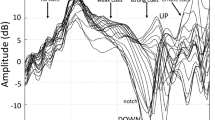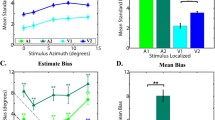Abstract
Previous research has demonstrated that, over a period of weeks, the auditory system accommodates to changes in the monaural spectral cues for sound locations within the frontal region of space. We were interested to determine if similar accommodation could occur for locations in the posterior regions of space, i.e. in the absence of contemporaneous visual information that indicates any mismatch between the perceived and actual location of a sound source. To distort the normal spectral cues to sound location, eight listeners wore small moulds in each ear. HRTF recordings confirmed that while the moulds substantially altered the monaural spectral cues, sufficient residual cues were retained to provide a basis for relearning. Compared to control measures, sound localization performance initially decreased significantly, with a sevenfold increase in front–back confusions and elevation errors more than doubled. Subjects wore the moulds continuously for a period of up to 60 days (median 38 days), over which time performance improved but remained significantly poorer than control levels. Sound localization performance for frontal locations (audio-visual field) was compared with that for posterior space (audio-only field), and there was no significant difference between regions in either the extent or rate of accommodation. This suggests a common mechanism for both regions of space that does not rely on contemporaneous visual information as a teacher signal for recalibration of the auditory system to modified spectral cues.






Similar content being viewed by others
References
Alais D, Burr D (2004) The ventriloquist effect results from near-optimal bimodal integration. Curr Biol 14:257–262
Aytekin M, Moss CE, Simon JZ (2008) A sensorimotor approach to sound localization. Neural Comput 20:603–635
Bergan JF, Ro P, Ro D, Knudsen EI (2005) Hunting increases adaptive auditory map plasticity in adult barn owls. J Neurosci 25:9816–9820
Bernard M, Pirim P, de Cheveigne A, Gas B, IEEE (2012) Sensorimotor learning of sound localization from an auditory evoked behavior. Ieee, New York
Bizley JK, King AJ (2008) Visual-auditory spatial processing in auditory cortical neurons. Brain Res 1242:24–36
Bizley JK, King AJ (2009) Visual influences on ferret auditory cortex. Hear Res 258:55–63
Brainard MS, Knudsen EI (1998) Sensitive periods for visual calibration of the auditory space map in the barn owl optic tectum. J Neurosci 18:3929–3942
Campenhausen M, Wagner H (2006) Influence of the facial ruff on the sound-receiving characteristics of the barn owl’s ears. J Comp Physiol A 192:1073–1082
Carlile S, King AJ (1994) Monaural and binaural spectrum level cues in the ferret: acoustics and the neural representation of auditory space. J Neurophys 71:785–801
Carlile S, Pralong D (1994) The location-dependent nature of perceptually salient features of the human head-related transfer function. J Acoust Soc Am 95:3445–3459
Carlile S, Leong P, Hyams S (1997) The nature and distribution of errors in the localization of sounds by humans. Hear Res 114:179–196
Carlile S, Jin C, Raad Vv (2000) Continuous Virtual Auditory Space Using HRTF Interpolation: Acoustic and psychophysical errors. In: Int Symp on Multimedia Info processing, pp 220–223. Sydney, Australia
Carlile S, Martin R, McAnnaly K (2005) Spectral information in sound localisation. In: Auditory spectral processing (Irvine DRF, Malmierrca M, eds), pp 399–434
Clifton RK, Clarkson MG, Gwiazda J, Bauer JA, Held RM (1988) Growth in head size during infancy—implications for sound localisation. Dev Psychol 24:477–483
Glasberg BR, Moore BC (1990) Derivation of auditory filter shapes from notched-noise data. Hear Res 47:103–138
Hochberg A, Tamhane AC (1987) Multiple Comparison Procedures. Wiley, New York
Hofman PM, Riswick JGAV, Opstal AJV (1998) Relearning sound localization with new ears. Nat Neurosci 1:417–421
Jin C, Corderoy A, Carlile S, Schaik A (2004) Contrasting monaural and interaural spectral cues for human sound localisation. J Acoust Soc Am 115:3124–3141
Kacelnik O, Nodal FR, Parsons CH, King AJ (2006) Training-induced plasticity of auditory localization in adult mammals. PLoS Biol 4:e71
King AJ (2004) The superior colliculus. Curr Biol 14:R335–R338
King AJ (2009) Visual influences on auditory spatial learning. Phil Trans R Soc B Biol Sci 364:331–339
King AJ, Carlile S (1993) Changes induced in the representation of auditory space in the superior colliculus by rearing ferrets with binocular eyelid suture. Exp Brain Res 94:444–455
King AJ, Walker KMM (2012) Integrating information from different senses in the auditory cortex. Biol Cybern 106:617–625
King AJ, Hutchings ME, Moore DR, Blakemore C (1988) Developmental plasticity in the visual and auditory representations in the mammalian superior colliculus. Nature 332:73–75
Kistler DJ, Wightman FL (1992) A model of head-related transfer functions based on principal components analysis and minimum-phase reconstruction. J Acoust Soc Am 91:1637–1647
Knudsen EI (2002) Instructed learning in the auditory localization pathway of the barn owl. Nature 417:322–328
Knudsen EI, Brainard MS (1991) Visual instruction of the neural map of auditory space in the developing optic tectum. Science 253:85–87
Knudsen EI, Knudsen PF (1989) Vision calibrates sound localization in developing barn owls. J Neurosci 9:3306–3313
Knudsen EI, Knudsen PF (1990) Sensitive and critical periods for visual calibration of sound localization. J Neurosci 10:222–232
Knudsen EI, Esterly SD, Olsen JF (1994) Adaptive plasticity of the auditory space map in the optic tectum of adult and baby barn owls in response to external ear modification. J Neurophysiol 71:79–94
Kumpik DP, Kacelnik O, King AJ (2010) Adaptive reweighting of auditory localization cues in response to chronic unilateral earplugging in humans. J Neurosci 30:4883–4894
Leong PHW, Carlile S (1998) Methods for spherical data analysis and visualisation. J Neurosci Methods 80:191–200
Linkenhoker BA, Knudsen EI (2002) Incremental training increases the plasticity of the auditory space map in adult barn owls. Nature 419:293–296
Middlebrooks JC (1992) Narrow-band sound localization related to external ear acoustics. J Acoust Soc Am 92:2607–2624
Middlebrooks JC, Green DM (1992) Observations on a principal components analysis of head-related transfer functions. J Acoust Soc Am 92:597–599
Middlebrooks JC, Makous JC, Green DM (1989) Directional sensitivity of sound-pressure levels in the human ear canal. J Acoust Soc Am 86:89–108
Oldfield SR, Parker SPA (1984) Acuity of sound localization: a topography of auditory space II: pinna cues absent. Perception 13:601–617
Otte RJ, Agterberg MJH, Van Wanrooij MM, Snik AFM, Van Opstal AJ (2013) Age-related hearing loss and ear morphology affect vertical but not horizontal sound-localization performance. J Assoc Res Otolaryngol 14:261–273
Parseihian G, Katz BFG (2012) Rapid head-related transfer function adaptation using a virtual auditory environment. J Acoust Soc Am 131:2948–2957
Pick H, Warren D, Hay J (1969) Sensory conflict in judgments of spatial direction. Percept Psychophys 6:203–205
Radeau M, Bertelson P (1974) The after-effects of ventriloquism. Q J Exp Psychol 26:63–71
Recanzone GH (1998) Rapidly induced auditory plasticity: the ventriloquism aftereffect. Proc Natl Acad Sci U S A 95:869–875
Recanzone GH (2009) Interactions of auditory and visual stimuli in space and time. Hear Res 258:89–99
Roder B, Teder-Salejarvi W, Sterr A, Rosler F, Hillyard SA, Neville HJ (1999) Improved auditory spatial tuning in blind humans. Nature 400:162–166
Schroeder CE, Foxe J (2005) Multisensory contributions to low-level, ‘unisensory’ processing. Curr Opin Neurobiol 15:454–458
Shaw EAG (1974) The external ear. In: Keidel WD, Neff WD (eds) Handbook of sensory physiology. Springer, Berlin, pp 455–490
Van Wanrooij MM, Van Opstal AJ (2005) Relearning sound localization with a new ear. J Neurosci 25:5413–5424
Van Wanrooij MM, Van Opstal AJ (2007) Sound localization under perturbed binaural hearing. J Neurophysiol 97:715–726
Wahba G (1981) Spline interpolation and smoothing on a sphere. AIAM J Sci Stat Comput 2:5–16
Wightman FL, Kistler DJ (1989) Headphone simulation of free field listening. I: stimulus synthesis. J Acoust Soc Am 85:858–867
Woods TM, Recanzone GH (2004) Visually induced plasticity of auditory spatial perception in Macaques. Curr Biol 14:1559–1564
Wozny DR, Shams L (2011) Recalibration of auditory space following milliseconds of cross-modal discrepancy. J Neurosci 31:4607–4612
Wright BA, Zhang YX (2006) A review of learning with normal and altered sound-localization cues in human adults. Int J Audiol 45:S92–S98
Zahorik P, Bangayan P, Sundareswaran V, Wang K, Tam C (2006) Perceptual recalibration in human sound localization: learning to remediate front-back reversals. J Acoust Soc Am 120:343–359
Zwiers MP, Van Opstal AJ, Paige GD (2003) Plasticity in human sound localization induced by compressed spatial vision. Nat Neurosci 6:175–181
Author information
Authors and Affiliations
Corresponding author
Rights and permissions
About this article
Cite this article
Carlile, S., Blackman, T. Relearning Auditory Spectral Cues for Locations Inside and Outside the Visual Field. JARO 15, 249–263 (2014). https://doi.org/10.1007/s10162-013-0429-5
Received:
Accepted:
Published:
Issue Date:
DOI: https://doi.org/10.1007/s10162-013-0429-5




